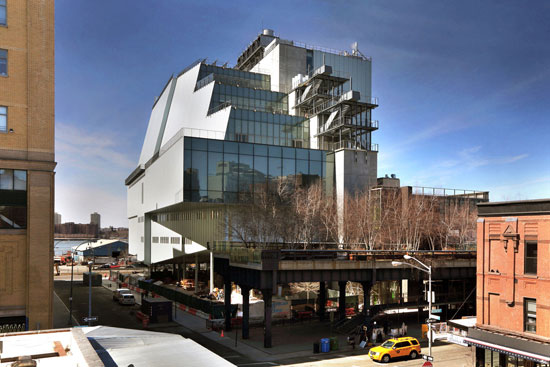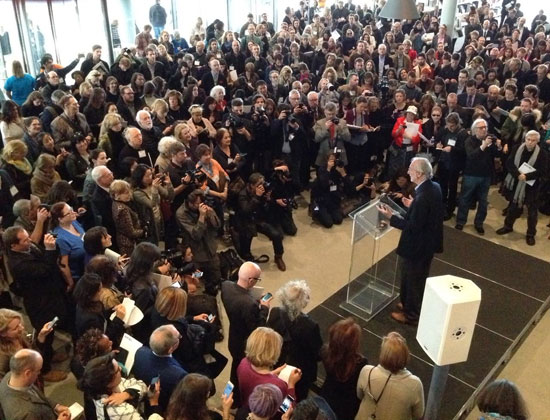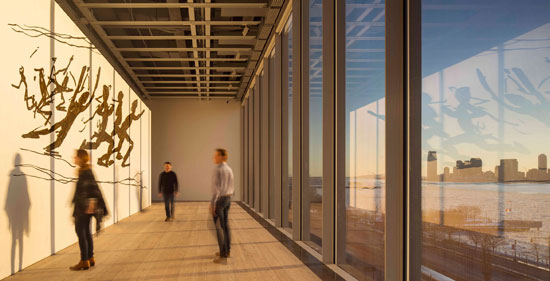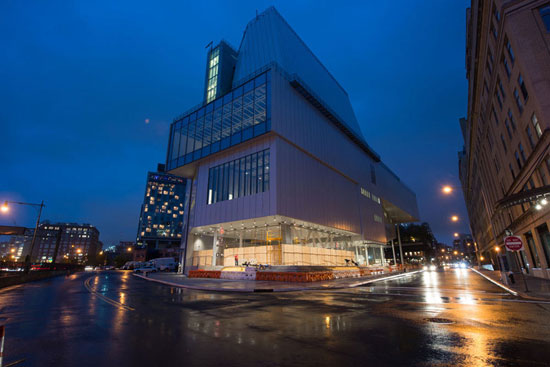The Whitney opened the lid on its new Renzo Piano headquarters so the fortissimo fanfare could be heard all over town. Not to put a damper on the excitement of adding a concert grand to the High Line, but our Piano arrived out of tune.
This is the latest museum project by the starchitect whose Morgan Library make-over the Times called “dazzling” and “sublime.” From every angle, the new Whitney with its industrial chic style is more like the back side of a Frank Gehry concert hall. For comparison, Gehry’s vastly more inspiring IAC headquarters is one of many prettier projects in the neighborhood on view from the cascading terraces of the new Whitney.
.

Whitney Museum of American Art. Photograph by Ed Lederman.
.
To be fair, part of the problem is that there are has been so much extraordinary new construction along the High Line designed by Jean Nouvel, Shigeru Ban, and Caesar Pelli, not to mention Diller Scofidio and Renfro, which designed the elevated park itself. With the addition of Piano, it’s Pritzker row along the Hudson.
At the mobbed press opening for the new, nine-story home for the Whitney, the maestro graciously saluted his clients, director Adam Weinberg and board president Neil Bluhm, and tipped his hat to the old Marcel Breuer edifice uptown, a gloomy “inverted ziggurat” that only a clique of historians would go to their theoretical ramparts to defend.
“I loved that building,” Piano declared, which I suspect is architectural diplomacy, because his new building is the inversion of everything Breuer advocated. Piano added with a disarming laugh that he would like the department of sanitation building on the Hudson River that blocks the westward view of the Whitney to “disappear soon.” All that was missing at the podium was one of those dynamite plungers you see in old movies that Piano could have depressed for an implosive collapse recorded for inclusion as a video piece in the next biennial (which has been postponed to 2017).
.

Piano addressing the crowd at the new Whitney. Photo by Ke Ming Liu.
.
To understand my disappointment in the visual poverty of the exterior, consider the age-old division between poetry and prose. It can be applied to design as well as literature, art and music. The gestural poetry of a de Kooning or Pollock is a strong contrast to the austere prose argument of Andy Warhol or Donald Judd.
Consider the difference between the melodies of poets like Chopin or Schumann and the pensive pace of novelists like Sibelius or Mahler. Some architects are poets. Their buildings connote lyricism, including Gehry, Tadao Ando and Frank Lloyd Wright. Others tend toward prose, including Piano’s Pompidou Center and Yoshio Taniguchi’s MoMA New York.
This is not in itself a sign of banality, as prose can be as masterfully written as poetry (see Hemingway, Ernest). Prose can also be prosaic, however, and the new Whitney headquarters, with the grim exterior of a corporate headquarters, is 28,000 tons of awkward angles, flatly uninteresting white planes and brooding recesses, including the sense of foreboding in the approach from civilization (the east, where the city lies, as opposed to the garbage facility or the docks or the meatpackers to the west) to the main entrance.
As I work near the Morgan, I have been struck more and more by the prose of that opaque white wall on its south side. I fear the new Whitney has been born with this plain face, especially as viewed from the High Line, where connoisseurs of architecture who climb the stairs for a decent view will likely be disappointed.
.

The Whitney Museum of American Art as seen from the High Line. Photograph by Timothy Schenck.
.
At the new Whitney, under a cantilevered entrance on Gansevoort Street, the “largo”at the southeast corner is really a huge bar and, disappointingly, the first museum feature beckoning tourists from the meatpacking district under the stairs to the highline. The landscaping by Piet Oudolf is underwhelming and Piano brazenly called the tiny corner of shadow a “piazza,” which drew snorts.
The choppy and inelegant terraces facing the city, which begin on the eighth floor and communicate (“West Side Story”-style) by steel fire escapes, will be lovely on sunny days. The little bump-out promontories from which Manhattan can be enjoyed are copycat features from the High Line and will be a great place to sneak a kiss as well as take photos.
Along those lines, a huge grey leather couch facing a vast window on the Hudson on the fifth floor will be the perfect make-out spot at the end of biennial openings and should have been a “naming opportunity” as in, “Excuse me, you’re sitting on my section of the couch—I paid for that signage.” The banal font stenciled on doors and walls for the ubiquitous donors’ names would infuriate me if I had written a check, but this problem has plagued museums since Mr. LeFrak stamped his Gucci loafers up at the Guggenheim in 1993 when he gave them $10 million (which now looks like chump change in this philanthropic climate).
Piano was ill served by his construction team, Cooper Robertson, who tragically seem to have had all the levels swiped from their toolboxes. An English designer who used to work for Apple was scrutinizing the exterior details, including patinated steel plates with unsightly blooms of rust already spreading and steel cable bannisters that wandered off center. “They spend $430 million and they can’t even get the bannisters aligned! I swear: me garden fence is straighter,” he laughed.
Officially the building cost $422 million, more than $50 million of which was publically funded. It was a week from the official opening and the punch list was clearly not completed. Filthy white beams crossed distressingly overhead in the eighth floor café and the mason left in charge of finishing the terrace caulking possibly had found the wine supply for one of the many VIP openings.
There is some good news. The 50,000 square feet of exhibition space is completely column-free and features vastly more sunlight in the galleries than ever penetrated the Piranesian gloom of the old Breuer prison, now in the hands in the Metropolitan. That means the art that has been brought out of dark storerooms for the opening exhibition (limply titled “America Is Hard to See” after a Robert Frost poem) can be viewed in what is literally a different light.
.

"Running People at 2,616,216 (1978–79)" by Jonathan Borofsky installed on the West Ambulatory, 5th floor, the inaugural exhibition, America Is Hard to See (May 1–September 27, 2015). Whitney Museum of American Art, New York. Photograph © Nic Lehoux.
.
In particular, on the west side of the building next to tall windows, visitors will have a penetrating light to reveal the brush strokes of Arshile Gorky’s iconic The Artist and his Mother (seventh floor), to inspect the surfaces of Jasper Johns’s White Target and Frank Stella’s magisterial Die Fahne Hoch (side by side on the sixth floor) and not far from the Hudson (turn around and look from the fifth floor window) a fluvial Cy Twombly grey blackboard painting from 1968.
A grove of David Smith sculptures on the eighth floor terrace is phenomenal (like a little visit to Storm King) and just inside the windows in the Abstract Expressionist galleries, the most powerful rooms in the museum, a Barnett Newman and Willem De Kooning are close enough to sunlight to pulse with color.
You know you have to go see the new Whitney of course, and you will dine well at the two Danny Meyer cafés (one on eight, the other on the first floor). You can even see a gallery for free on the first floor, a magnanimous and welcoming gesture considering the $22 ticket price. Just don’t expect poetry.
.

The Whitney in the evening, October 2014. Photograph by Timothy Schenck.
.
______________________
BASIC FACTS: The Whitney Museum of American Art opens to the public on May 1, 2015 at its new location located at 99 Gansevoort Street, New York, NY 10014. www.whitney.org
______________________
Copyright 2015 Hamptons Art Hub LLC. All rights reserved.
